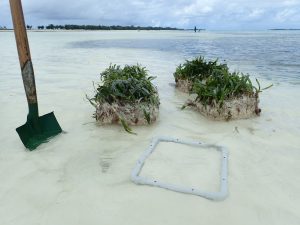Large-scale seagrass restoration project under way in Kiribati to combat climate change
Local communities in Tarawa, an island atoll in the Central Pacific nation of Kiribati, have initiated one of the first and largest seagrass restoration efforts in the Pacific in a project coordinated by SPREP.

With the support of the Ministry of Fisheries and an international seagrass restoration expert, Dr Paul Erftemeijer from DAMCO Consulting, villagers are restoring seagrass in areas where it had disappeared due to water pollution from untreated sewage discharge and sediment plumes from causeway construction.
In recent years, following completion of the causeway and repairs of broken sewage pipes, water quality in the lagoon has improved significantly. However, the natural recovery of the seagrass pastures will take many years without our support, as it relies predominantly on vegetative clonal growth from the remaining patches and meadows, and that is a slow process.

The restoration project excavates small sods of seagrass (complete with roots and sediment) from dense healthy meadows and transplants them in bare sand areas further west at similar depths, in areas that used to have seagrass before.
Dr Erftemeijer explains: “After careful site selection and test planting trials, we have now successfully transplanted 127 sods, totalling 22,000 seagrass plants, covering an area of about 3,000 square metres. The sods are growing well over a metre per year in all directions and are expected to merge into one continuous meadow within three to five years. The small gaps in the donor meadows, caused by the excavation of the sods, have been backfilled with sand and are expected to recover within six months”.

Up to 20 villagers per day participated in the restoration work during March 2020, including women, children and two disabled members of the community. There is a lot of excitement among the community and expectations are high, for the villagers are well aware of the many values and benefits from the seagrasses, including their role in sustaining fisheries.
The restoration will also benefit the country’s efforts to climate-proof the island against sea level rise and ocean acidification, as the plants bind the sediment (preventing erosion) and buffer the ocean’s pH.
Over the next months and years, Fisheries staff will monitor the survival and expansion of the transplanted seagrass patches. If proven successful, the Ministry plans to expand these efforts both on Tarawa and the other (outer) islands of Kiribati. Results will also be published to share experiences and inspire other island nations in the Pacific region to restore their seagrass resources.
The work is financially supported by the New Zealand Ministry of Foreign Affairs and Trade and the Government of the Principality of Monaco through the Pacific Partnership on Ocean Acidification project.







